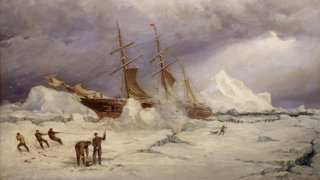The Pandora was built at the Pembroke Naval Dockyards in 1860. The ship was 146 feet long, 25 feet at the beam and a draft of 13, built of wood and displaced 570 tons. Although rigged for sail, her main means of propulsion was steam.
After 15 years of service with the Royal Navy, the vessel was purchased by the mariner and explorer, Sir Allen Young (1827-1915), who purchased her for an Arctic cruise. Young had previously sailed on the Fox with Leopold McClintock in search of Sir John Franklin and even though the fate of Franklin had been discovered he felt there was still more to be discovered about the lost explorer.
As it turned out he was able to add nothing new to the Franklin story, neither was he able to improve on the previous expeditions in search of a Northwest Passage.
1876 voyage of the Pandora
The following year he piloted Pandora north again for another attempt on the Northwest Passage, but before he could begin he received a request from the Admiralty to look for another explorer, Sir George Nares, who was leading an expedition to try and reach the North Pole via Smith Sound. Nares was not in fact in trouble and his expedition returned home without any serious mishap.
It was at this time that Pandora became nipped (trapped and under pressure) in the ice of Melville Bay, off northwestern Greenland.

The painting shows the crew using gun powder to try and relieve the pressure of the ice on the ship’s hull. Young prepared to abandon the ship but fortunately Pandora broke free.
The Pandora changes ownership and name
In 1877 Young sold Pandora to J. Gordon Bennett, an American newspaper publisher, who planned to sail her through the Bering Strait, making use of a warm ocean current called the Kuro Siwo, which he hoped, would carry the ship to the North Pole, across an open Polar Sea.
Bennett placed her under the command of the USS Navy but not before renaming her, Jeannette, after his sister. She departed San Francisco in 1879 under the command of Captain George W. De Long.
She made some progress, but the pressure of the ice became relentless and eventually, in June 1881, she was crushed and sank. Twenty crew members, including De Long, died before they could reach safety.
The wreck of Jeannette and the death of De Long ended speculation that there might be open water around the North Pole.
Further readings
Brown, R. N. Rudmose, and Elizabeth Baigent. "Young, Sir Allen William (1827–1915), merchant navy officer and polar explorer." Oxford Dictionary of National Biography.
De Long, George W. The voyage of the Jeannette. The ship and ice journals of George W. De Long, lieutenant-commander U.S.N. and commander of the Polar expedition of 1879-1881. Boston, Houghton, Mifflin and company, 1884.
Guttridge, Leonard F. Icebound. The Jeannette Expedition's quest for the North Pole. Shrewsbury: Airlife, 1988.
Young, Allen W. Sir. The two voyages of the Pandora. London, 1879.

